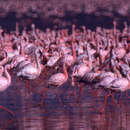en
names in breadcrumbs


Accidental visitor.
The lesser flamingo (Phoeniconaias minor) is a species of flamingo occurring in sub-Saharan Africa and western India.[4] Birds are occasionally reported from further north, but these are generally considered vagrants.
The lesser flamingo is the smallest species of flamingo, though it is a tall and large bird by most standards. The species can weigh from 1.2 to 2.7 kg (2.6 to 6.0 lb).[5] The standing height is around 80 to 90 cm (31 to 35 in).[6][7] The total length (from beak to tail) and wingspan are in the same range of measurements, from 90 to 105 cm (35 to 41 in).[6][8] Most of the plumage is pinkish white. The clearest difference between this species and the greater flamingo, the only other Old World species of flamingo, is the much more extensive black on the bill. Size is less helpful unless the species are together, since the sexes of each species also differ in height.
The extinct species Phoeniconaias proeses in the same genus, from the Pliocene of Australia, is thought to have been even smaller.[9]
The lesser flamingo may be the most numerous species of flamingo, with a population that (at its peak) probably numbered up to two million individual birds. This species feeds primarily on Spirulina, algae which grow only in very alkaline lakes. Presence of flamingo groups near water bodies is indication of sodic alkaline water which is not suitable for irrigation use. Although blue-green in colour, the algae contain the photosynthetic pigments that give the birds their pink colour. Their deep bill is specialised for filtering tiny food items.
Lesser flamingos are prey to a variety of species, including marabou storks, vultures, baboons, African fish eagles, jackals, hyenas, foxes, Great white pelicans, Martial Eagle, and big cats.[10][11]
In Africa, where they are most numerous, the lesser flamingos breed principally on the highly caustic Lake Natron in northern Ngorongoro District in Arusha Region of Tanzania. Their other African breeding sites are at Etosha Pan, Makgadikgadi Pan, and Kamfers Dam. The last confirmed breeding at Aftout es Saheli in coastal Mauritania was in 1965. Breeding occurred at Lake Magadi in Kenya in 1962 when Lake Natron was unsuitable due to flooding. In the early 20th century, breeding was also observed at Lake Nakuru.[12]
The species also breeds in southwestern and southern Asia. In 1974, they bred at the Rann of Kutch, but since then, only at the Zinzuwadia and Purabcheria salt pans in northwestern India.[12][4] Some movement of individuals occurs between Africa and India.[13]
Like all flamingos, they lay a single chalky-white egg on a mound they build of mud. Chicks join creches soon after hatching, sometimes numbering over 100,000 individuals. The creches are marshalled by a few adult birds that lead them by foot to fresh water, a journey that can reach over 20 mi (32 km).
Despite being the most numerous species of flamingo, it is classified as near threatened due to its declining population and the low number of breeding sites, some of which are threatened by human activities.[14]
The population in the two key East African lakes, Nakuru and Bogoria, have been adversely affected in recent years by suspected heavy metal poisoning, while its primary African breeding area in Lake Natron is currently under threat by a proposed soda ash plant by Tata Chemicals.[15] The only breeding site in South Africa, situated at Kamfers Dam, is threatened by pollution and encroaching development.[16]
The lesser flamingo is one of the species to which the Agreement on the Conservation of African-Eurasian Migratory Waterbirds applies.
Painting by C. G. Finch-Davies
Video taken at Disney's Animal Kingdom
Huge flock at Lake Bogoria, Kenya
Adult Feeding, Jamnagar, India
Juvenile Feeding, Jamnagar, India
Juvenile, Jamnagar, India
Adult, Jamnagar, India
Juvenile, Jamnagar, India
Juveniles, Jamnagar, India
The lesser flamingo (Phoeniconaias minor) is a species of flamingo occurring in sub-Saharan Africa and western India. Birds are occasionally reported from further north, but these are generally considered vagrants.